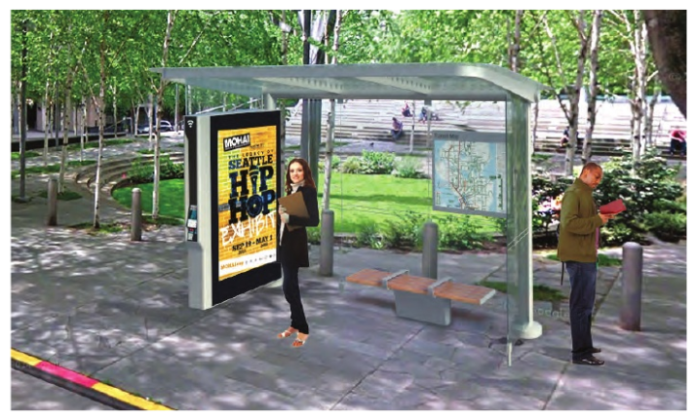Cities across the country are trying to improve their public realms by putting an emphasis on enhancing the pedestrian and transit user experience. Seattle had intended to follow suit through a concerted effort by using a public-private partnership. The city had selected Intersection, a winning bidder, which promised installation of modern transit shelters and high-tech information and WiFi kiosks throughout Downtown Seattle and South Lake Union at no cost to the city. Intersection had also offered to pay the city between $97 million and $167 million over 20 years as compensation for sole operational rights. The proposal, however, was put on ice some time between late last year and early this year.
Prelude to a program and its demise
In 2015, Seattle issued a request for proposals (RFP) to implement a comprehensive street furniture program (known as the “Coordinated Street Furniture Program“) to enhance the public realm in Downtown Seattle and South Lake Union. In describing the purpose of the program, the RFP stated that:
The Coordinated Street Furniture Program will include design, fabrication, installation, and high quality maintenance of an organized, coherent, Seattle-inspired set of transit shelters and information kiosks in downtown Seattle and South Lake Union that improve the walkability, livability, and quality of the downtown experience while providing a revenue stream to the City of Seattle for key downtown transportation improvements.
A contractor would be guaranteed 15 years to operate the program with a possible extension of up to an additional five years (20 years total).
Behind the scenes, the Seattle Department of Transportation (SDOT) had been coordinating with vendors to deliver modern street furniture improvements, primarily to the benefit of transit riders. SDOT wanted to deploy more functional and welcoming transit shelters than the bleak ones often used by King County Metro Transit.
The reality on the ground now is that transit shelters routinely face riders away from the street and usually contain confined and uncomfortable space for more than one or two people. Metro’s bus shelters also greatly impede the pedestrian flow on narrow sidewalks, which tends to be the norm in the city. Often the first point of contact with transit, the poorly designed transit shelters are a dismal reflection on transit as a brand and experience (and honestly could give many of the contenders in the Streetsblog “Sorriest Bus Stop” competition a serious run for their money).
Beyond aesthetics, the RFP expressed a desire for transit shelters to incorporate more useful rider information, sufficient waiting space, lighting, and ideally seating, which would replace all existing transit shelters in Downtown and South Lake Union, except for RapidRide-branded transit shelters. Another primary function that a contractor would need to bring to city streets was multifunctional information kiosks, but SDOT had hoped to also include public toilets, bike facilities (e.g., bike corrals, counters, and bikeshare stations), newspaper boxes, public WiFi, and trash and recycle bins as part of the Coordinated Street Furniture Program. As a precursor to implementation, the RFP acknowledged that the city sign code would need changing to accommodate advertising on transit shelters and kiosks.
After issuing the RFP in 2015, the city selected a preferred vendor to deliver the program and began negotiations on how to do it. And last September, The Urbanist spoke to SDOT officials who confirmed that the project was still actively underway and that news of the program was due out in early 2018. However, that time came and went with no announcement of the program publicly. In May, The Urbanist followed up with SDOT for an update on the program. SDOT officials said that priorities had since changed and that the program had been put on an indefinite hold, likely meaning permanent cancellation. No vendor, including Intersection, is being considered for a contract. The decision to impose the hold came not from within the department but after discussions with the Mayor’s Office, according to the officials.
Who is Intersection?
Intersection, a transit advertising outfit from New York City, was chosen as the vendor for the contract. The company has contracts with other local agencies like King County Metro, Sound Transit, and Kitsap Transit to provide services for their advertising programs. While Intersection specializes in transit advertising, the company has expanded in developing transit rider amenity programs over the years, which are bundled with their advertising offerings. That kind of bundle strategy is common globally, and transit aficionados may be familiar with JCDecaux that has similar products nationally and abroad.
Intersection’s transit shelter and kiosk proposal
Intersection had planned to deploy their full kit of transit shelters and kiosks throughout Downtown Seattle and South Lake Union. Some 88 transit shelter and 200 kiosk locations had been identified for deployment throughout the program area. As part of the proposal, Intersection had committed to footing capital, repair, and maintenance costs as well revenue-sharing with the city. Specifically, the contract would include obligations like:
- Covering the full cost to construct the transit shelter and kiosk facilities as well as managing ongoing operations, maintenance, and repair of them;
- Handling advertising on the facilities and customer relationships with advertisers; and
- Paying the city a share of advertising revenue, which could well exceed $100 million over 20 years.
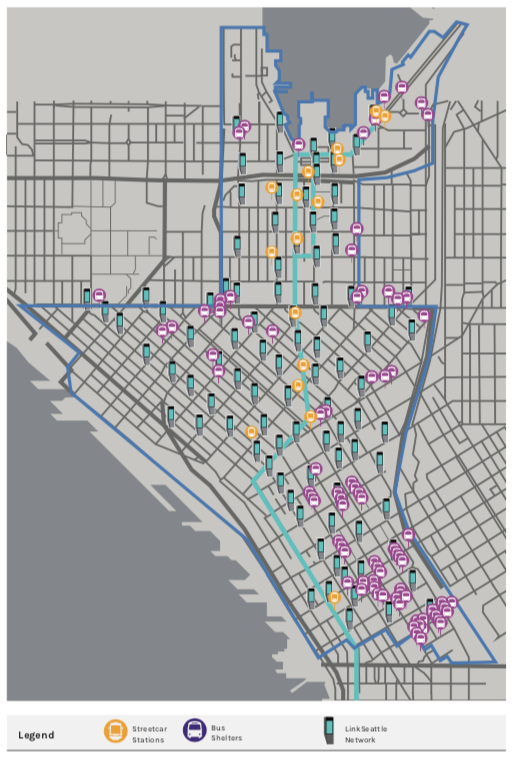
Generally speaking, the new transit shelters would be heavily concentrated in the downtown business core and a smattering of locations in the Denny Triangle, Belltown, and South Lake Union along major bus lines. New transit shelters would also be located at streetcar stops. Since Metro has special branding for RapidRide, the contract would not involve replacement of those shelters and facilities.
Intersection provided two different transit shelter options, one of which includes modern seating that would be more comfortable than Metro’s wired benches (both Intersection’s and Metro’s benches include anti-homeless features, though in Intersection’s case the benches would deter manspreaders). The design of the transit shelters are meant to be flexible and accommodate hilly terrain by better nestling into the sidewalk. They could also be designed to ensure that the maximum amount of sidewalk space is retained. Both transit shelter options would also include other similar features, such as:
- Space for static maps (Oran Viriyincy’s Seattle Transit Map is prominently featured);
- LED lighting systems built into the roof;
- Full clearance for transparent glass panels; and
- LinkSeattle WiFi kiosks.
The design of the shelters would still provide protection from the elements in addition to providing greater security, more comfort, and less sidewalk clutter.
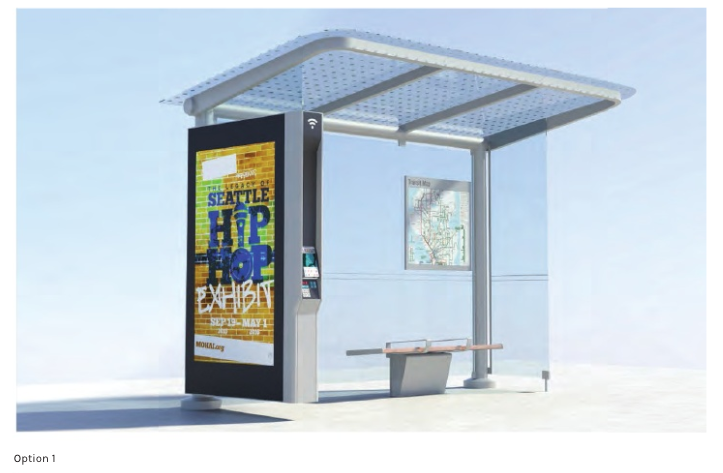
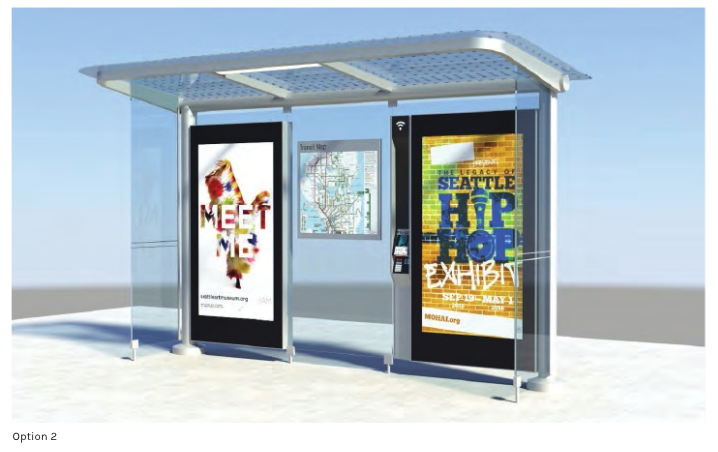
Another set of facilities that Intersection had planned to place in the street were the LinkSeattle kiosks. These would be evenly distributed throughout the Downtown Seattle and South Lake Union program area to increase their benefit for public use and bolstering advertising revenues.
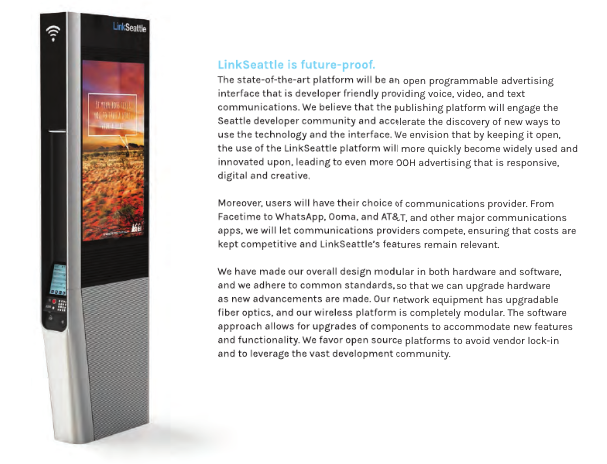
The LinkSeattle kiosks that Intersection had planned to roll out would have provided a variety of public benefits (although some had raised data privacy concerns) with features like:
- Free and fully enabled gigabit WiFi (up to 200 times faster than typical public WiFi) that can reach 150 feet with good coverage above and below ground;
- Interactive wayfinding information and emergency response functions;
- Sensors to collect environmental data for open source use;
- Public messages of the city’s choosing;
- Free local phone calls; and
- Functionality for access to city services.
Intersection also promised a program to regularly clean and maintain its facilities. In cases where assets need to be fixed or are in need of immediate attention, the company would address those issues within 24 hours in order to keep their facilities safe and accessible to the public.
More than $100 million in possible city revenues
The financial information from the the proposal specifies a range of payments to the city over a 20-year period, assuming the deal lasted that long. On the low end, the city was due around $97 million under the “Annual Minimum Guarantee” that Intersection would pay out if advertising revenues were not as robust as expected. $167 million could be a more realistic number based upon advertising sales projections by Intersection.
In the early years of the partnership, the Annual Minimum Guarantee would be fairly low at $146,622 in year one and $1,961,700 in year three. The Annual Minimum Guarantee revenue share, however, would quickly ramp up to an even $5 million in year eight and $7.1 million by year 20. Of course, the annual payment amounts could be vastly higher if advertising sales met Intersection’s projections, averaging about $8 million in payments to the city each year.
What’s being left on the table
A lot is being left on the table with the city walking away from the partnership with Intersection, and unfortunately it’s not clear why city officials apparently have chosen to do so, despite interviews with SDOT officials. The Urbanist contacted the Mayor’s Office to get further clarity on the issue, but received no comment. What should be obvious, however, is that this selected proposal offers a lot to like as far as public-private partnerships go:
- The new transit shelters could dramatically enhance the rider experience with improved lighting, comfort, information, and weather protection, which would generally encourage more people to take transit.
- The digital kiosks would offer ultra-fast free public WiFi and could help people find their way around the city and keep their phones running. In the digital age, information is an incredibly important part of the economy, and free internet service helps disadvantaged and marginalized folks stay connected.
- The city gets these benefits for free with all of the liability and responsibility held by a third party. That same third party would pay the city somewhere between $4.8 million and $8 million per year for the privilege to do so, which itself could go directly back into any number of transit, pedestrian, and transit access improvements.
Imagine the city spending several million dollars more per year just to construct wider sidewalks and new curb ramps, roll out more bike lanes, install additional transit signal priority, and build more public seating near transit stops in the city center. These improvements could add up quickly in a few short years. Alternatively, the city could dedicate revenue to major capital transit expansion programs that are suffering from apparent funding shortfalls like the Center City Connector and citywide RapidRide+ programs. If the initial Coordinated Street Furniture Program turned out to be successful, there’s no reason to believe that it couldn’t be replicated in other neighborhoods and districts in the city to deliver similar benefits.
With Move Seattle appearing to downshift in project delivery, the Coordinated Street Furniture Program could partially shift some projects and investments back into gear. If there’s enough agitation from the public, the gears could get turning to bring the program back from the brink.
First Improvements to Third Avenue’s Transit Mall Will Be Subtle
Stephen is a professional urban planner in Puget Sound with a passion for sustainable, livable, and diverse cities. He is especially interested in how policies, regulations, and programs can promote positive outcomes for communities. With stints in great cities like Bellingham and Cork, Stephen currently lives in Seattle. He primarily covers land use and transportation issues and has been with The Urbanist since 2014.


